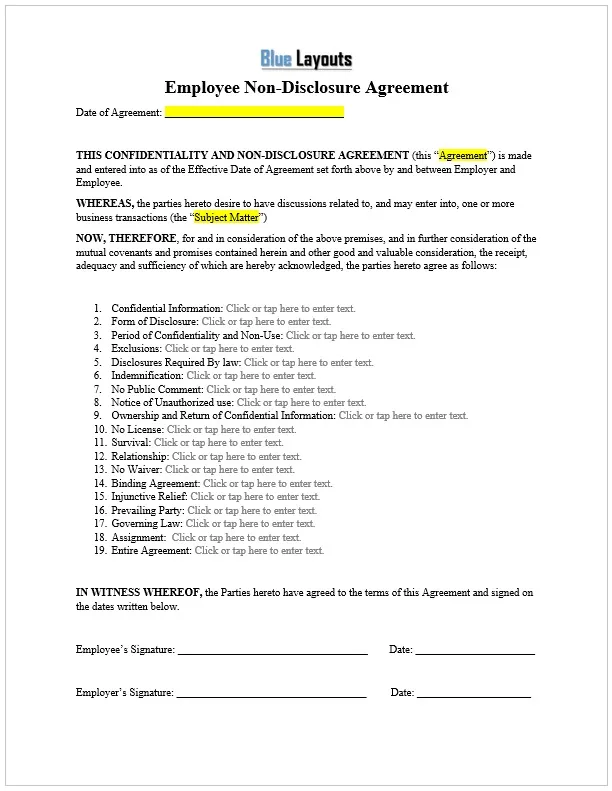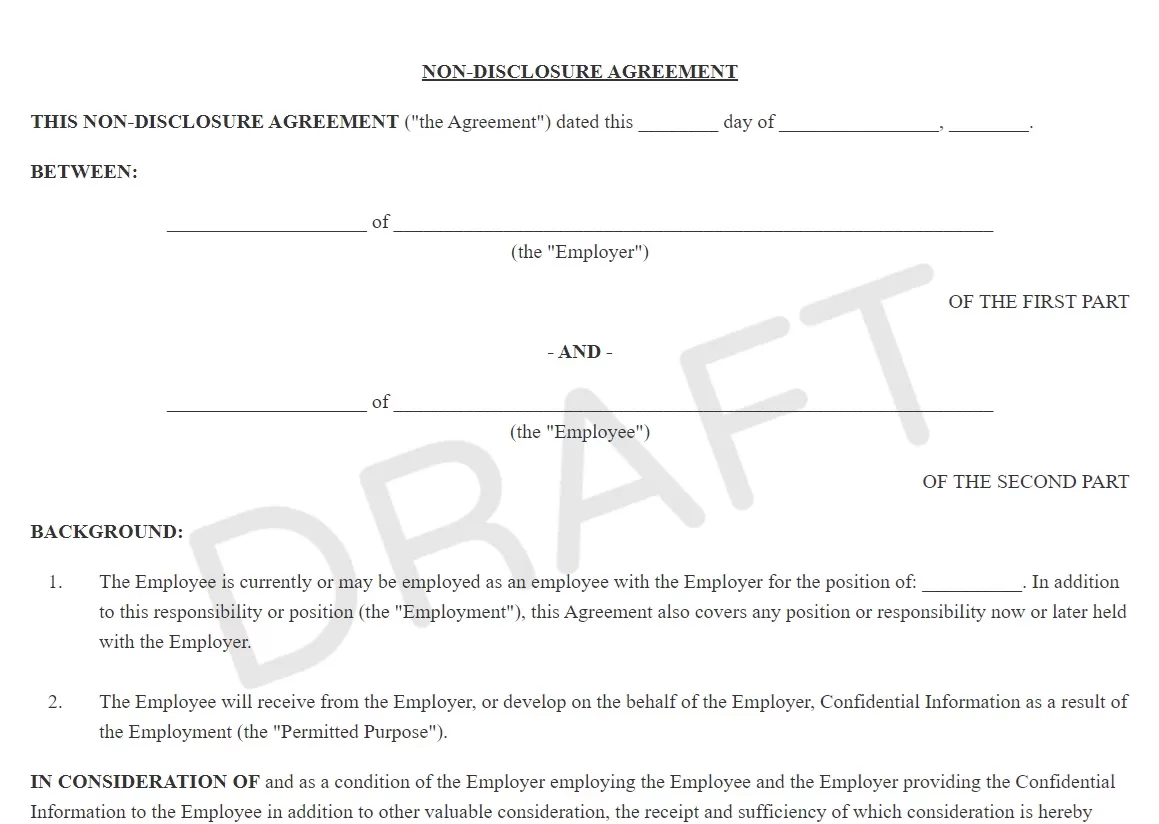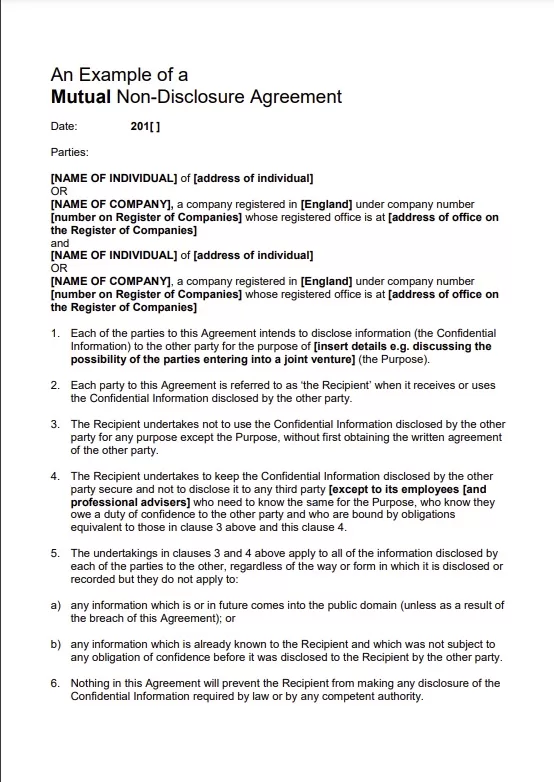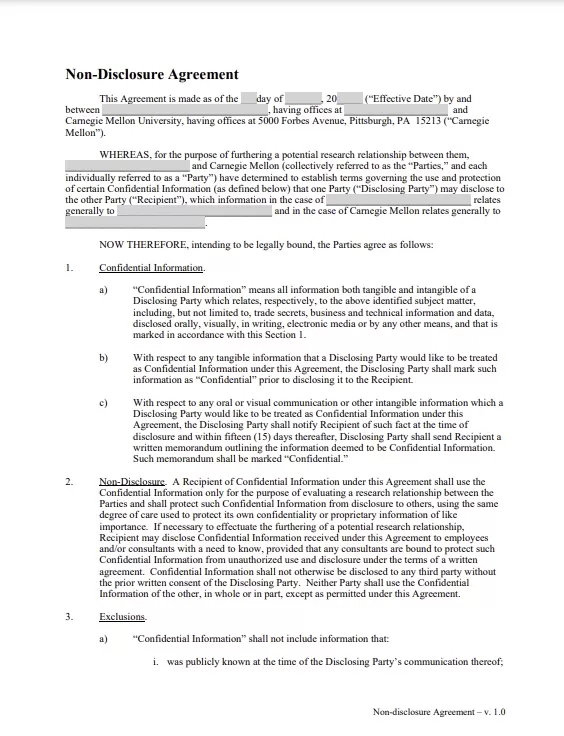A Non-Disclosure Agreement (NDA) is also known as a confidentiality agreement; it is a legally binding contract that serves to create a confidential relationship between the parties involved in it. An NDA is used for keeping information secret from third persons. Here are key elements typically found in an NDA:
- Parties Involved: The agreement always identifies the person sharing the information (disclosing party) and the person who normally receives the information (receiving party).
- Definition of Confidential Information: Describes materials that are in possession of the organization, which should not be known by outsiders. These may consist of – but are not limited to – blueprints of future presentations, cheques, software codes, etc.
- Obligations of the Receiving Party: Informs the obligations of the recipient of this confidential information which include that he/ she must keep it secret, not share it with anyone else unless allowed to do so, and make sure that the information is only used according to what was agreed upon.
- Exclusions from Confidential Information: It is defined that NDA does not cover certain information. Such information normally includes that which is already public knowledge, which was already in possession of the recipient, independently created by the recipient, and disclosed by no fault of the recipient.
- Duration of Confidentiality: The duration within which the information should be kept confidential is stipulated. This may be for a certain number of years or until the occurrence of a particular event.
- Consequences of Breach: The person making the revelation can take legal actions like getting an order or asking for monetary repair in case anybody defaults on the NDA terms.
- Miscellaneous Provisions: This has some legal provisions that include clauses such as jurisdiction, severability, and integration.
In business, they are frequently used for such purposes as making deals, recruiting staff members, or engaging in joint projects where the sharing of confidential information is involved. They guarantee that such data is shielded from unauthorized access and can offer grounds for prosecution in case a breach of the agreement happens.
Top Free Non-Disclosure Agreement Templates
Here is my selection of the top 5 Free Non-Disclosure Agreement Templates to assist you quickly.
***** Template Rated 1st *****

Source: BlueLayouts.org
**** Template Rated 2nd ****

Source: hbs.edu
*** Template Rated 3rd ***

Source: Lawdepot.com
*** Template Rated 4th ***

Source: Service.gov.uk
*** Template Rated 5th ***

Source: cmu.edu
When dealing with sensitive information, particularly intellectual property, a Non-Disclosure Agreement (NDA), also known as a Confidentiality Agreement, is essential. Here’s a detailed guide on how to write a Non-Disclosure Agreement effectively:
1. Understand the Purpose of an NDA:
When you share any form of private data with another party that should not be revealed to others, a Non-Disclosure Agreement must be in place. Legally, it binds the second party to secrecy against all forms of intellectual property violation: the latest innovation, the business plan, or any information that has been classified as private.
2. Identify the Parties Involved:
Make sure that each party who is taking part in the contract is clearly stated. Full names, addresses, and roles should be specified (e.g., discloser and recipient). See to it that every entity, whether human beings or corporate organizations, is properly named so that no legal loophole may arise.
3. Define Confidential Information:
Define confidential details in the treaty. Examples given are technical data, business strategies, customer lists, financial matters, and any other sensitive information that may be considered under such an agreement. Add more particulars for purposes of enhancing understanding and legal enforceability.
4. Obligations of the Receiving Party:
Specify the duties of the receiving party when it comes to confidential information. This will involve the usage of such information, how one should keep it safe & the measures they should put in place to ensure there are no unauthorized disclosures.
5. Exclusions from Confidential Information:
Clear list items explained in it do not qualify as confidential material Such lists generally encompass data that is available in the public domain, known to the receiver beforehand, or which he/she might have come up with on his/her own sans having access to any confidential information.
6. Term of the Agreement:
Mention the time period for which the non-disclosure agreement (NDA) will last. Also, you should add when the receiving party should protect the classified data and when the deal can come to an end.
7. Return of Information:
On termination of the agreement let it be aimed how to return the confidential information to the discloser or to be destroyed.
8. Consequences of Breach:
Explain the possible legal implications of breaking the terms of confidentiality. These may involve fines and other legal solutions.
9. Jurisdiction:
Choose the legal jurisdiction that will control the agreement. It is important in case of disagreements and make sure the agreement is understood according to the laws of the stated state or country.
10. Signatures:
In order for it to become legally binding, both parties must sign this agreement which requires that there be a witness or notary involved if necessary.
Free NDA Templates and Samples:
There are several free templates and samples available online in MS Word and PDF formats that are useful to anyone in drafting an NDA and would be certainly of help to a beginner in this profession. Here’s how to utilize these resources:
- Review Multiple Samples: Look at various templates to understand different approaches and clauses.
- Customize According to Needs: Adjust the model to accommodate specific aspects of your circumstances. Since one universal model does not exist, customization is essential.
- Consult with Legal Advisor: Before signing off on anything, speak with your local attorney (legal practitioner) so as to ascertain the validity and enforceability of every term in your area of jurisdiction.
By observing these instructions and taking advantage of the available resources that you have, you are able to protect your intellectual property effectively by using a properly composed Non-Disclosure Agreement.

